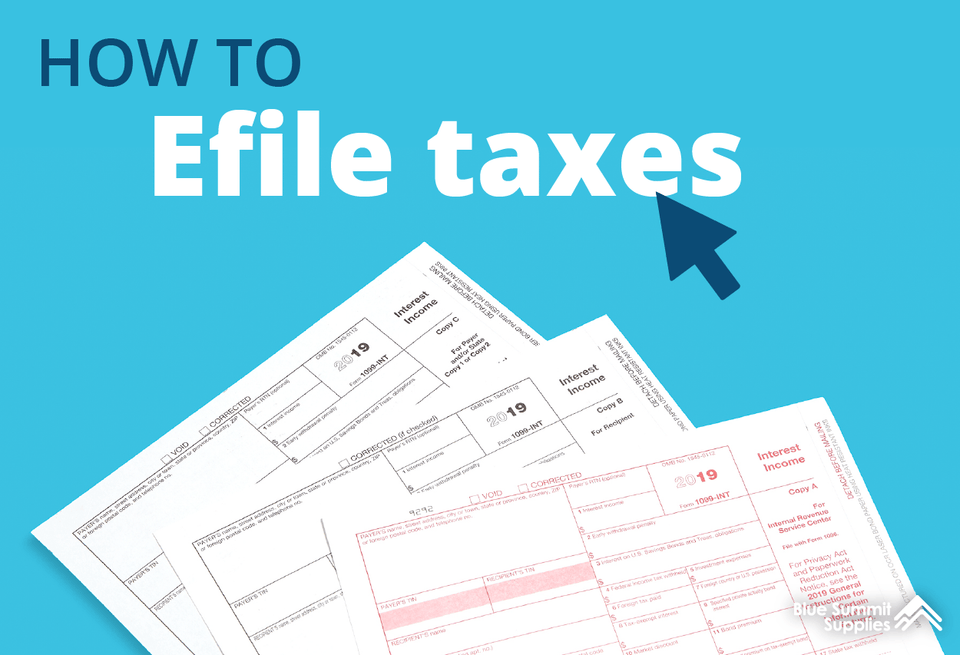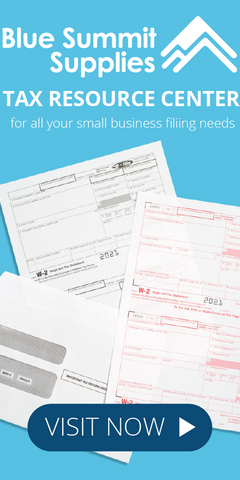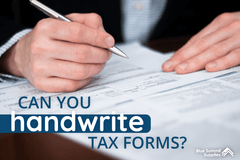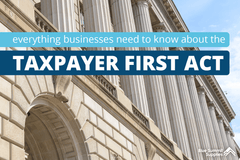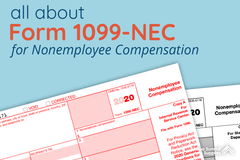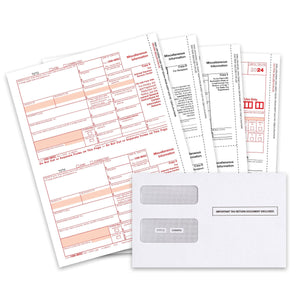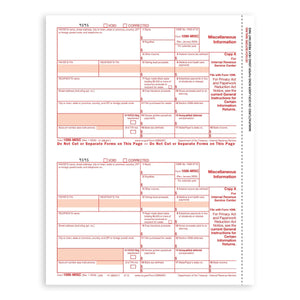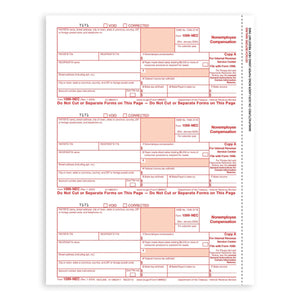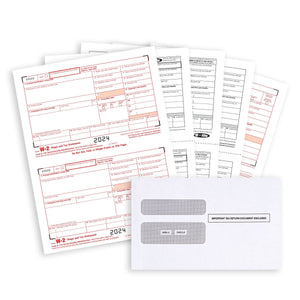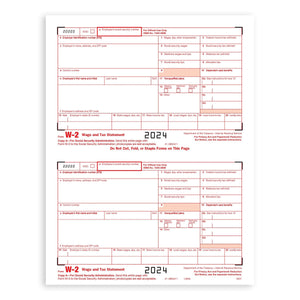
Most of us these days probably wish we could just file our taxes by swiping through some app on our phones. While unfortunately we’re not there yet, efiling is a good option for those hoping to enjoy a slightly more modernized tax season (and avoid any trips to the post office).
In fact, this process is so much smoother that the government is starting to require that more companies do it. With the signing of the Taxpayer First Act in 2019, companies hitting certain thresholds of how many forms they file will be required to efile. Within a couple of years basically every company and many partnerships will have no choice but to efile.
But while efiling your taxes is actually quite easy, the process isn’t always clear. Luckily, we’re here to answer questions about how to efile taxes the right way every time.
What exactly is the Taxpayer First Act?
According to ComplyRight.com, “as part of the Taxpayer First Act, many businesses will no longer be able to submit paper forms. Currently, electronic filing is mandatory if the employer has 250 or more forms to complete. Over the next three years, the threshold will be significantly reduced.
- In 2020, the number is the same. Companies filing 250 or more forms must e-file.
- In 2021, the number drops to 100 forms.
- In 2022, businesses filing just 10 or more forms must electronically file.”
In short, by 2022, almost all businesses (since most businesses file 10 or more forms) will be required to electronically file. So why wait?
In this article, I’ll go over:
- What is efiling?
- Why should I efile?
- Who can efile their taxes?
- Does it cost money to efile?
- What information do I need to efile?
- Where do I go to efile my taxes?
- How do I pay (or get my refund) when you efile?
- How long will it take to get my tax refund when I efile?
- Can I efile my taxes late?
- Is efiling safe?
What is Efiling?
Efiling is pretty straightforward: It’s simply electronically sending all of your tax forms to the IRS rather than mailing them in. Now, this isn’t as simple as emailing in all of your tax documents to the IRS (please don’t do that). Instead, it can only be done through software that is pre-approved by the IRS. More on that if you keep reading.

Why Should I Efile?
Obviously we can’t give you tax advice—the decision about whether to efile should be yours or decided in conjunction with your tax preparer. But there are a few benefits to efiling that had 92% of taxpayers submitting their returns this way in 2018.
- It saves time: For you AND for the IRS. You don’t have to spend time printing out forms, going to the post office, and the like. And the IRS doesn’t have to spend time transcribing your returns into their systems. (Bonus: This also means there’s less room for errors.)
- Fewer mistakes: The fact that people at the IRS aren’t literally typing your tax returns into their system also leaves less room for human errors. According to the IRS, 20% of paper returns have mistakes, but only about 1% of electronic ones do.
- Faster confirmation, faster refunds: This time-saving means that, often, you’ll get your refunds faster if you use efiling and select direct deposit to receive your refund. At the very least, you’ll be told within minutes whether your tax return has been accepted or rejected by the IRS, giving you quick peace of mind that it’s been received (or letting you take the necessary steps to fix it quickly).
- It uses less paper: Because who doesn’t want to save a tree when it’s easy to do so?
Who Can Efile Their Taxes?
Nearly anyone over the age of 16 with any kind of tax situation is eligible for efile. That means you can efile your individual tax returns, you can efile your 1099s if you’re self employed, you can efile your small business taxes. Things get a bit more complex when you’re a partnership or large corporation, so it’s worth checking with your tax preparer here—but you’re still eligible for efile.

There are also some extra limitations when it comes to using the IRS’ Free File or Free Fillable Formsprograms. For instance, if you need to add statements or PDF attachments, you will not be able to use this program to efile your return. (But may still be able to efile through other tax preparation software or with the help of your CPA.)
There are also very rare cases where efiling won’t work. If you are trying to claim a qualified dependent deduction and somebody else has already filed a return claiming that same dependent, the IRS may need extra information to support your deduction that cannot be completed through the efiling process.
Finally, you’ll want to double check in your state whether they accept efiled returns for state taxes. Most do, but you never know. If you do want to efile your state return, you will also have to efile your federal return due to new regulations.
Does it Cost Money to Efile?
The short answer is, it depends, but it most likely won’t cost you anything extra.
Individuals with income below $66,000 can use the IRS’ Free File software, making this a completely cost-free affair.
If you make over that amount, you have a few options (which may or may not cost you a little extra). The IRS also provides Free File Fillable Forms, which are a little less user friendly than the Free File software, but can be a good option if you’re comfortable doing your taxes yourself. If you need a little extra help, most online tax preparation services (like TurboTax or H&R Block) give you the option to efile, typically for free or included in the cost of your service. Finally, if you work with a tax preparer or CPA, they should be able to efile your return for you as long as they’re authorized IRS efile providers, and most don’t charge anything extra for this outside of their standard fees. If you aren’t sure whether they offer this service, ask or search the IRS’ database of authorized providers.

What Information Do I Need to Efile?
For the most part, you just need to gather all the same financial information as you would if you were filing your taxes normally! W-2 forms, 1099 forms, bank statements, receipts for things you want to deduct, etc.
The only unique thing you’ll need is easy access to last year’s tax returns—you’ll use your adjusted gross income from last year’s return to verify your identity this year if you’re using the Free File program, and will also need your total tax paid from last year if you’re using an online tax preparation service or CPA.

Where Do I Go to Efile MyTaxes?
As mentioned above, there are a few services you can use to efile your taxes:
- The IRS’ Free File software or Free Fillable Forms
- Your favorite online tax preparation service or software(just double check they include efiling as an option)
-
A tax preparer or CPA (just ask whether they provide efiling or search the IRS’ database of authorized providers)

How Do I Pay If I Owe Money on My Efiled Return?
If you owe money when you efile your return, and are filing simple taxes using the Form 1040 series, by far the easiest and fastest way to pay is to keep it all electronic and pay with a bank transfer using IRS Direct Pay. You can do this at the same time as efiling your return, so you’ll be one and done.

You can also opt to pay with a credit or debit card, though you may incur a small fee.
If you’re using a tax preparation software or working with a tax preparer, they may be able to process your payment for you.
Finally, if none of this is your thing, you can prepare a payment voucher using Form 1040-V and mail it to the IRS with a check or money order.
How Will I Get My Refund If I Efile?
Just like when you file paper taxes, you can opt to receive your refund either through direct deposit to your bank or paper check. Direct deposit will be much faster!
How Long Will It Take to Get My Tax Refund When I Efile?
While it’s always a little hard to gauge how long a refund will take, the IRS says that by efiling your return and choosing direct deposit to get your refund, you’re putting yourself on the fast track—because these processes are so much more efficient than paper returns, it’s definitely the fastest way to get your money (possibly in as few as 7 days!). That said, it’s always possible a return can require additional review and take longer. You can always use “Where’s My Refund?”on IRS.gov or the IRS2Gomobile app to check in on the status of your refund.

Can I Efile My Taxes Late?
It depends on how late we’re talking. Efiling opens towards the end of January every year, and closes sometime in November (specific dates are announced in the IRS QuickAlerts library each year as the date gets closer).
So if you’re filing for a previous tax year or are really coming in under the wire in December, you’re going to have to do it the old fashioned paper way. But if you’re just running a little behind, you should be good to efile.

Is Efiling Safe?
The last thing on your mind before you dive headfirst into efiling your taxes is whether it’s safe to send all this personal financial information into the digital ether. The answer here is yes—or at least just as safe as anything else.
The IRS has worked hard to make sure their efile technology meets strict security guidelines, using modern encryption and putting other strong safeguards in place to prevent theft of any of your information. So, you can either send your returns through an encrypted network—or through the mail where theoretically it could get lost or anyone could get their hands on it.
This article is designed to provide accurate and authoritative information. However, it is not a substitute for legal advice and does not provide legal opinions on any specific facts or services. The information is provided with the understanding that any person or entity involved in creating, producing or distributing this article is not liable for any damages arising out of the use or inability to use this product. You are urged to consult an attorney concerning your particular situation and any specific questions or concerns you may have.
 For more informative articles about office supplies, subscribe to our email newsletter!
For more informative articles about office supplies, subscribe to our email newsletter!
Never fear, you won't begin receiving daily sales emails that belong in a spam folder. Instead, we promise a fun weekly roundup of our latest blog posts and great finds from across the web. And if you lose interest, it's always easy to unsubscribe with a single click.

